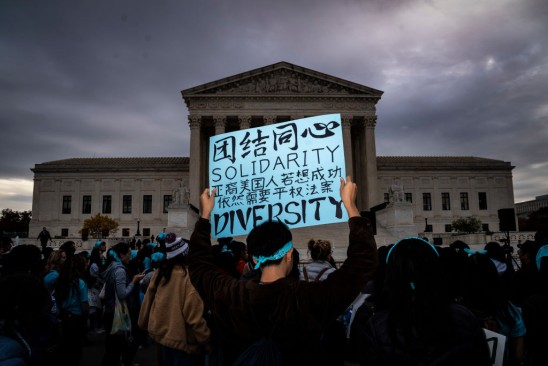SCOTUS bars affirmative action

The Supreme Court has ruled against the use of race as a factor in higher education admissions. The 6-3 decision will force colleges to scrap affirmative action policies designed to increase minority representation on campus. Schools must now “decide where racial diversity ranks among priorities that can include academic performance, achievement in extracurricular activities … and preferences for alumni and donors,” The Wall Street Journal notes. While expected, the ruling is a reversal from the court’s last big decision on the subject, which in 2016 reaffirmed the use of racial preferences in public university admissions.
By Saundra Latham, Editor at LinkedIn News
5 takeaways from the Supreme Court decision overturning affirmative action in college admissions

Activists from Students for Fair Admissions celebrated the affirmative action opinion outside the US Supreme Court in Washington on Thursday.KENNY HOLSTON/NYT
The US Supreme Court on Thursday effectively barred universities from using race-based affirmative action in admissions, overturning decades of precedent that had allowed affirmative action programs.
Here are five takeaways from the landmark decision:
The decision wasn’t close
The court, which has veered well to the right in recent years, voted along ideological lines against race-conscious admissions programs at Harvard University and the University of North Carolina. Chief Justice John Roberts wrote the majority opinion.
It rests on the 14th Amendment’s Equal Protection Clause
The court cited the Equal Protection Clause of the 14th Amendment, which Congress proposed and the states ratified after the Civil War. The clause provides that no state shall “deny to any person … the equal protection of the laws.”
The amendment has been cited for decades in efforts to end racial discrimination. Roberts’s opinion noted the 14th Amendment’s role in that fight, but he ultimately relied on it to end policies the universities said were crucial to boost the racial diversity of the student body.
”Eliminating racial discrimination means eliminating all of it,” Roberts wrote in his opinion, which was joined by Justices Brett Kavanaugh, Samuel Alito, Amy Coney Barrett, Neil Gorsuch, and Clarence Thomas.
“The student must be treated based on his or her experiences as an individual — not on the basis of race,” Roberts wrote. “Many universities have for too long done just the opposite. And in doing so, they have concluded, wrongly, that the touchstone of an individual’s identity is not challenges bested, skills built, or lessons learned but the color of their skin. Our constitutional history does not tolerate that choice.”
The dissenting justices said the ruling would deepen racial inequality on campuses
“The Equal Protection Clause of the Fourteenth Amendment enshrines a guarantee of racial equality. The Court long ago concluded that this guarantee can be enforced through race-conscious means in a society that is not, and has never been, colorblind,” Justice Sonia Sotomayor said in a dissent, which was joined by Justices Elena Kagan and Ketanji Brown Jackson.
She said “race-conscious college admissions policies have advanced the Constitution’s guarantee of equality,” and that the court’s decision would make racial inequality in higher education worse.
“The Court cements a superficial rule of colorblindness as a constitutional principle in an endemically segregated society where race has always mattered and continues to matter,” Sotomayor wrote. “The Court subverts the constitutional guarantee of equal protection by further entrenching racial inequality in education.”
“The devastating impact of this decision cannot be overstated,” she said.
In a separate dissent, Jackson wrote, “With let-them-eat-cake obliviousness, today, the majority pulls the ripcord and announces ‘colorblindness for all’ by legal fiat. But deeming race irrelevant in law does not make it so in life.”
What will the impact be?
President Biden said Thursday that America should not let the court’s decision “be the last word” on the matter, urging universities to develop new policies that continue to promote racial diversity on campuses.
“Opportunity is for everyone, not just a few. We need a new path forward,” he said.
The Biden administration has said that curtailing race-conscious college admissions would have a “destabilizing” effect that would cause the ranks of Black and Latino students to plummet at the nation’s most selective schools.
Proponents of affirmative action are concerned that less-diverse student bodies will eventually mean fewer professionals of color in industries from medicine to politics.
Colleges across New England are preparing for the end of affirmative action by reviewing policies and programs that could be at risk in light of the court’s ruling and studying what has been learned from states like California, which spent years after the ban using race-neutral measures to try to build back diversity, consultants and higher education leaders have said.
Sotomayor said in her dissent “universities can and should continue to use all available tools to meet society’s needs for diversity in education. Despite the Court’s unjustified exercise of power, the opinion today will serve only to highlight the Court’s own impotence in the face of an America whose cries for equality resound.”
It’s the second time in two years the court has overturned a landmark case
It was the second time in two years the conservative majority has toppled a landmark ruling that has been in place for decades.
Last year, the justices overturned the 1973 Roe v. Wade decision, which guaranteed abortion rights.
The limited use of affirmative action on college campuses was first approved 45 years ago in Regents of the University of California v. Bakke, with the court citing the importance of filling US campuses with students from varied backgrounds.
Tal Kopan of the Globe staff contributed to this report. Material from Globe wire services and previous Globe stories was used in this report.
By Globe Staff





